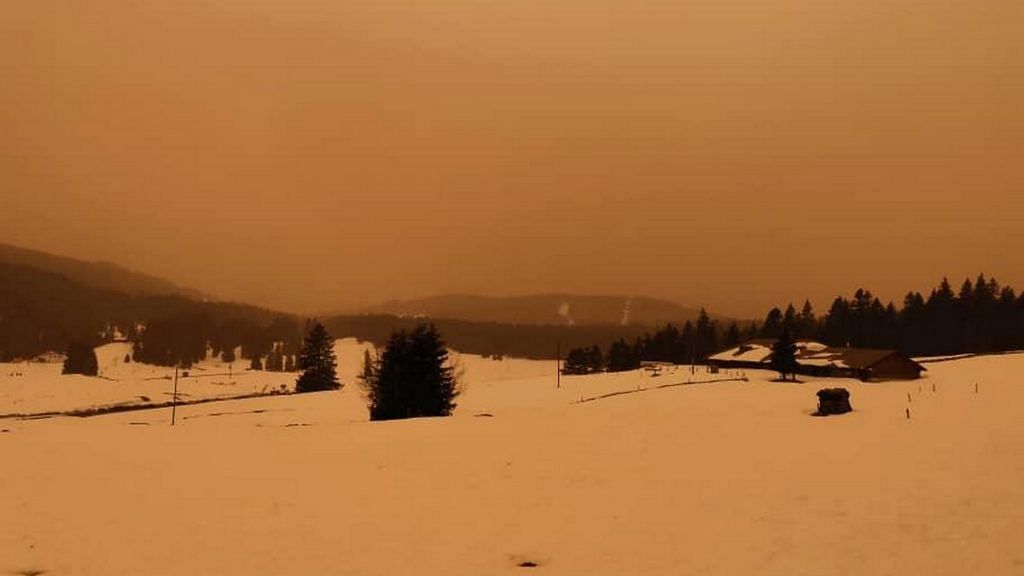Chennai: A huge plume of dust from the Sahara desert in Africa travelled north this week, turning southern European skies orange and lowering air quality across multiple countries. The data about the dust plume’s origin and the distance it covered was provided by the Copernicus Atmosphere Monitoring Service (CAMS), a part of the EU’s Copernicus Earth observation satellite programme.
According to CAMS, sandstorms originating in northeast Algeria led to aerosol plumes, which transported dust to southern and central Europe, giving the skies a red hue that has been labelled ‘Martian’. Additionally, dust was also deposited on snow in multiple countries and on mountains, which was visible in images shared on social media as well as satellite imagery.
When snow becomes sand#Saharan dust has transformed the landscape in parts of Europe.
📷Jura mountains on border between Switzerland and France from WMO's Lu Ren
Details of WMO's work to improve warnings of this major environmental and health hazardhttps://t.co/LKpsn1w2LJ pic.twitter.com/AdqJPHC4fr
— World Meteorological Organization (@WMO) February 6, 2021
A Grandvalira #sablesaharien #pols #andorra 📷 @montpackers pic.twitter.com/cqa763zlWk
— Météo Pyrénées (@Meteo_Pyrenees) February 6, 2021
Winds can carry fine dust from the Sahara desert for hundreds of thousands of kilometres, depositing it atop large mountains across continents. Saharan dust has been detected as far away as the United States, the Caribbean, Scandinavia and Japan. It is also an important source of nutrients to oceans worldwide as well as to the Amazon rainforest, and impacts natural processes such as the formation of hurricanes.
However, the dust, which is classified as ‘PM10’ or fine particles with diameters between 2.5 micrometres and 10 micrometres, could pose health hazards to humans, aggravating breathing difficulties.
Also read: ‘What does Europe smell like?’ — 3-year project set to archive key scents from history
Dust forecasting
Since the dust from the Sahara desert travels large distances and is moved by wind processes, these plumes are tracked and their movement is forecast.
“During this current dust event, particles were transported along a thick plume that stretched from the surface up to approximately 5 km above the ground,” said the CAMS report from earlier this week.
“The CAMS team estimated that several micrograms of dust particles per square metre were deposited over much of Europe between 4-8 February, which is a few orders of magnitude larger than an average dust deposition for southern Europe of around 10-15 grams per square metre,” it noted.
CAMS data showed increased values of surface PM10 concentrations, which meant that fine particles got settled in a layer above the Earth’s surface. PM10 particles are also called “coarse particulate matter”, and are a source of pollution to humans and technology.
This dust, which is akin to that from construction sites, waste burning and pollen, can cause allergic reactions and breathing difficulties in humans and animals. PM10 particles have been associated with increase and worsening of respiratory diseases such as asthma.
Additionally, the dust also blocks out sunlight, which tends to affect the output of solar panels across the continent. Lowered visibility is also a risk to road and air transport.
Mineral dust shapes ecosystems
The Sahara desert is the largest source of dust in the world that is carried by wind, also known as ‘aeolian’ dust. Aeolian Saharan dust plays a crucial role in shaping ecosystems around the world as it carries nutrients and minerals.
Dust from the Sahara carries iron, and makes up about half of all aeolian dust fed to the oceans. In oceanic waters, the development of phytoplankton is limited by the low availability of iron, which the microscopic plant needs for photosynthesis. Large quantities of dust blowing into the oceans regularly feed these plants, causing “blooms” that are visible in images.
Phytoplankton forms the base of several aquatic food chains, feeding and nourishing marine life, which is why it is called the “primary producer” of the ocean. The organism also generates about half the oxygen in the Earth’s atmosphere.
Studies have found that 71 to 87 per cent of iron in the Atlantic Ocean comes from Saharan dust.
The dust also feeds nutrients like phosphorus to the Amazon basin in South America, one of the most fertile places on the planet. Because the Amazon is a rainforest, such nutrients in the soil are easily swept away by rains, but the aeolian dust replenishes it.
Saharan Air Layer
Dust from deserts like the Sahara and the Thar in India and Pakistan rises up in the air, to a height beyond 2.5 km. Under the appropriate conditions, typically during the northern hemisphere’s “dust season” of June-July, fine dust can collect high up in the atmosphere, forming a layer called the Saharan Air Layer (SAL).
This layer, first theorised and modelled in 1972, can be nearly 5 km in thickness and potentially hold up to 60 million tonnes of dust. The SAL is also visible as a haze in satellite images.
SAL also plays a crucial role in tempering the formation and intensity of hurricanes and cyclones. Cyclones form due to excessive warmth in the air, causing moisture to rise in a convective process on an enormous scale. By blocking out the sun, the dust keeps the temperatures above the surface of water and in the oceans relatively cooler — sometimes preventing the formation of tropical storms and hurricanes, but mostly slowing down its intensification.
Also read: Toxic metals released since Industrial Revolution in Europe found in the Himalayas
